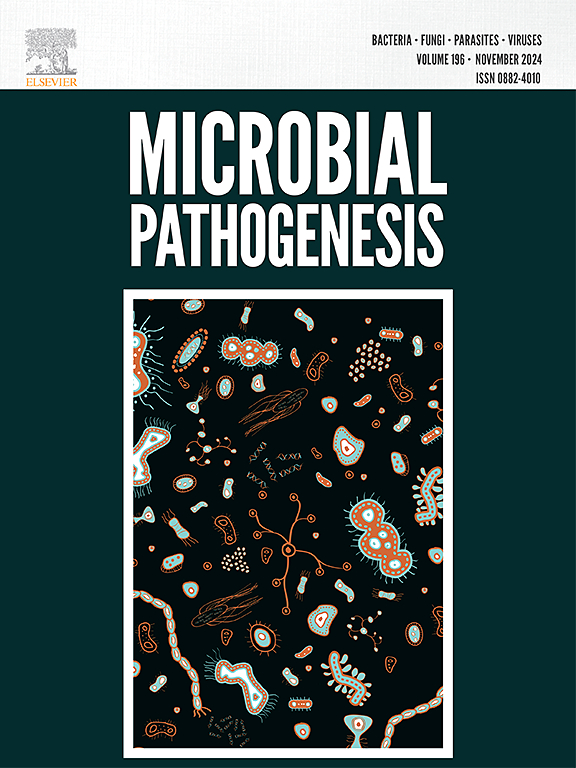TMT-based quantitative proteomics analysis reveals the inhibitory mechanism of CD-g-CS against the biofilm formation of Staphylococcus xylosus
IF 3.5
3区 医学
Q3 IMMUNOLOGY
引用次数: 0
Abstract
Chitosan-grafted β-cyclodextrin (CD-g-CS) serves as an excipient combining drug delivery capacity with antimicrobial activity. Previous studies have demonstrated that the CD-g-CS nanoformulations have significant inhibitory effects on bacterial biofilms, although the mechanism of action remains unclear. Consequently, the present study used tandem mass tag (TMT)-based quantitative proteomics coupled with quantitative PCR (qPCR) to investigate the mechanism underlying CD-g-CS-mediated inhibition of Staphylococcus xylosus (S. xylosus) biofilm formation at the protein level. The results showed that 903 proteins were identified to be altered in S. xylosus treated with CD-g-CS, of which 430 were down-regulated and 500 were up-regulated. Bioinformatics analysis revealed that these differentially expressed proteins (DEPs) have different molecular functions and are involved in different molecular pathways. CD-g-CS affected the functional pathways of S. xylosus in terms of ribosomes, phosphotransferase system (PTS), tricarboxylic acid (TCA) cycle, and nitrate respiration. These pathways affected the stability and morphology of biofilms, which in turn interfere with biofilm formation. These results provide a critical excipients for future development of anti-biofilm pharmaceutical formulations, offering novel solutions to combat biofilm infections.

基于tmt的定量蛋白质组学分析揭示CD-g-CS对木糖葡萄球菌生物膜形成的抑制机制
壳聚糖接枝的β-环糊精(CD-g-CS)是一种集给药能力和抗菌活性于一体的赋形剂。先前的研究表明,CD-g-CS纳米制剂对细菌生物膜具有显著的抑制作用,尽管其作用机制尚不清楚。因此,本研究采用基于串联质量标签(TMT)的定量蛋白质组学与定量PCR (qPCR)相结合的方法,从蛋白水平研究cd -g- cs介导的木糖葡萄球菌(S. xylosus)生物膜形成的抑制机制。结果表明,CD-g-CS处理木糖,共鉴定出903个蛋白发生改变,其中下调430个,上调500个。生物信息学分析表明,这些差异表达蛋白具有不同的分子功能,参与不同的分子途径。CD-g-CS可以影响木糖酵母核糖体、磷酸转移酶系统(PTS)、三羧酸(TCA)循环和硝酸盐呼吸等功能途径。这些途径影响生物膜的稳定性和形态,进而干扰生物膜的形成。这些结果为未来抗生物膜药物配方的开发提供了重要的辅料,为对抗生物膜感染提供了新的解决方案。
本文章由计算机程序翻译,如有差异,请以英文原文为准。
求助全文
约1分钟内获得全文
求助全文
来源期刊

Microbial pathogenesis
医学-免疫学
CiteScore
7.40
自引率
2.60%
发文量
472
审稿时长
56 days
期刊介绍:
Microbial Pathogenesis publishes original contributions and reviews about the molecular and cellular mechanisms of infectious diseases. It covers microbiology, host-pathogen interaction and immunology related to infectious agents, including bacteria, fungi, viruses and protozoa. It also accepts papers in the field of clinical microbiology, with the exception of case reports.
Research Areas Include:
-Pathogenesis
-Virulence factors
-Host susceptibility or resistance
-Immune mechanisms
-Identification, cloning and sequencing of relevant genes
-Genetic studies
-Viruses, prokaryotic organisms and protozoa
-Microbiota
-Systems biology related to infectious diseases
-Targets for vaccine design (pre-clinical studies)
 求助内容:
求助内容: 应助结果提醒方式:
应助结果提醒方式:


